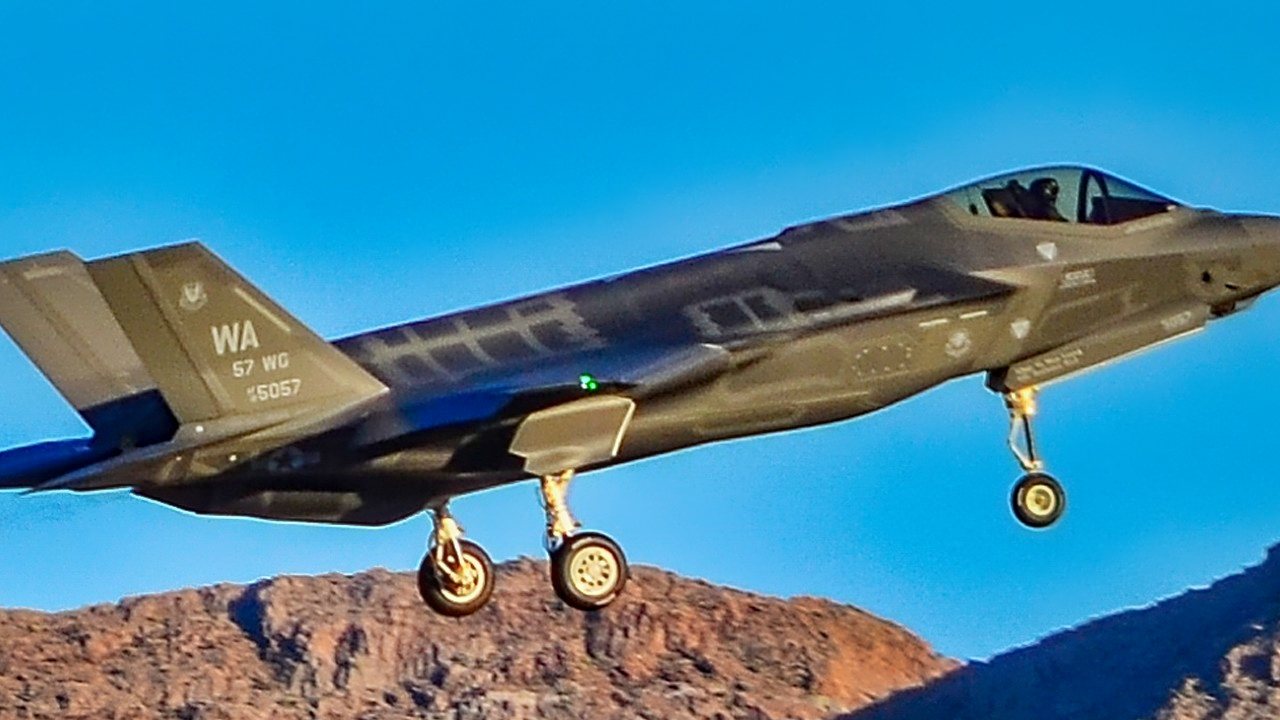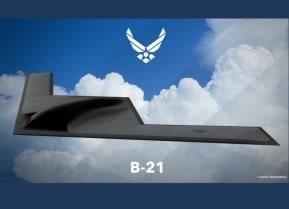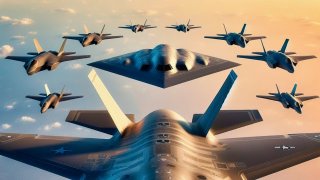Mind Blowing Combo: F-35 Fighters and B-2 Bombers Are Training Together
Together, the F-35 and B-2 would be a nearly unstoppable force – one that could penetrate an enemy's air defenses, hit targets, and make a return home practically before anyone was the wiser.
The Lockheed Martin F-35 Lightning II is arguably the most advanced fighter aircraft in the world today, while the Northrop Grumman B-2 Spirit is the only true stealth bomber in service. Individually the two aircraft are highly capable and should be feared by any potential adversary.
Together, the F-35 and B-2 would be a nearly unstoppable force – one that could penetrate an enemy's air defenses, hit targets, and make a return home practically before anyone was the wiser. Earlier this month the two platforms operated together over the North Sea as a reminder of that fact.
United States Air Forces in Europe & Air Forces Africa announced that on December 13, U.S. Air Force B-2 Spirits assigned to Whiteman Air Force Base, Missouri, conducted a flight from their home station to a training area over the North Sea, linking with United Kingdom F-35 Lightning II's during a long-planned Bomber Task Force (BTF) mission.
The recent deployment provided combined integration with Allied fifth-generation aircraft intended to enhance multi-domain interoperability and continue the development of fifth-generation tactics, techniques, and procedures.
"Strategic bomber missions aim to deter conflict, showcasing our rapid response capability and reinforcing commitment to the U.K. and NATO," said Gen. James Hecker, USAFE-AFAFRICA commander and Allied Air Command commander. "Operating alongside RAF fifth-gen fighters enhances our strength through combined training."
Such routine BTF missions serve to demonstrate the Department of Defense's (DoD's) ability to project power and global reach through conventional bomber employment as well as its flexibility and agility to respond to evolving challenges in the operational environment.
The pair of B-2 Spirit bombers executed the mission with aerial refueling support from a KC-135 Stratotanker assigned to the 100th Air Refueling Wing at RAF Mildenhall, U.K., and achieved all mission objectives. One B-2 returned to Whiteman AFB the same day and one landed at RAF Fairford.
The B-2 – America's Stealth Bomber
Able to fly 6,000 nautical miles without refueling, and travel at high subsonic speeds, the B-2 remains the only heavy-hitting aircraft that can strike any part of the world within hours.
Since its introduction in 1997, the Northrop Grumman heavy bomber has often been the first to fight. It was designed to penetrate anti-aircraft defenses and can deploy both conventional and thermonuclear weapons. It is also the only acknowledged aircraft that can carry large air-to-surface standoff weapons in a stealth configuration.
The B-2 provides the penetrating flexibility and effectiveness inherent in manned bombers, the United States Air Force noted, citing its low-observable ("stealth") characteristics that provide it the unique ability to penetrate an enemy's most sophisticated defenses and threaten its most valued, and heavily defended, targets. Its capability to penetrate air defenses and threaten effective retaliation provides a strong, effective deterrent and combat force well into the 21st century.

The revolutionary blending of low-observable technologies with high aerodynamic efficiency and large payload further provides the B-2 with important advantages over existing bombers. Its low observability offers it greater freedom of action at high altitudes, thus increasing its range and a better field of view for the aircraft's sensors.
The Spirit's low observability is derived from a combination of reduced infrared, acoustic, electromagnetic, visual, and radar signatures. These signatures make it difficult for the sophisticated defensive systems to detect, track, and engage the B-2. Many aspects of the low-observability process remain classified; however, the B-2's composite materials, special coatings, and flying-wing design all contribute to its "stealthiness."
The B-2 can carry up to sixteen B-61 or megaton-yield B-83 nuclear gravity bombs on the rotary launchers inside its two bomb bays. The aircraft’s avionics are even hardened versus the electromagnetic pulses generated by nuclear blasts.

Its unrefueled range is approximately 6,000 nautical miles (9,600 kilometers), which allows pilots to complete the mission and get back home!
The first B-2 rolled out of the bomber's final assembly facility in Palmdale, Calif., in November 1988 and it flew for the first time on July 17, 1989. Originally, the Air Force had plans for 132 B-2 Spirits, but as the aircraft was a product of the Cold War, it was originally designed to penetrate Soviet air defenses.
Following the dissolution of the Soviet Union, Congress slashed the budget for the Spirit, which cut production to just twenty-one aircraft. There are currently just twenty B-2s in service with the United States Air Force today, while the service plans to continue to operate them until the mid-2030s, the end of the line is already in sight.
The Northrop Grumman B-21 Raider, which was officially unveiled a year ago, will first supplement and then replace the B-2, by which time the Spirit will have been in the sky for just around thirty-five years.
The RAF's F-35
The first of the United States-built F-35B Lightning II touched down at RAF Marham in Norfolk in 2018 – with 617 Squadron, famously known as the Dambusters, becoming the first to be equipped with the advanced fifth-generation aircraft.

A second squadron, 809 Naval Air Squadron (NAS), was stood up to fly the Lightning II earlier this month. Dating back to the Second World War, 809 Naval Air Squadron was selected by the First Sea Lord, Admiral Sir George Zambellas, to receive the F-35 because of its illustrious history as a strike and attack squadron.
In addition, each of the UK's two new Queen Elizabeth-class aircraft carriers can operate with up to 36 F-35Bs.
Author Experience and Expertise
Peter Suciu is a Michigan-based writer. He has contributed to more than four dozen magazines, newspapers, and websites with over 3,200 published pieces over a twenty-year career in journalism. He regularly writes about military hardware, firearms history, cybersecurity, politics, and international affairs. Peter is also a Contributing Writer for Forbes and Clearance Jobs. You can follow him on Twitter: @PeterSuciu.
All images are Creative Commons.


